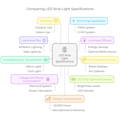Table of Contents
Introduction
The lighting landscape has undergone a dramatic transformation with the advent of LED technology. LED strip lights, in particular, have gained immense popularity due to their versatility, energy efficiency, and design flexibility. According to a report by Grand View Research, the global LED lighting market size was valued at USD 55.4 billion in 2022 and is expected to expand at a compound annual growth rate (CAGR) of 12.3% from 2023 to 2030. This growth is driven by increasing awareness of energy conservation and the declining cost of LED technology. For professionals in the lighting industry, understanding the intricacies of LED strip light specifications is essential for staying competitive and meeting client demands.
Key Parameters to Compare
B. Luminous Efficacy (Lumens per Watt): This measures the efficiency of the strip light, indicating how much light is produced per watt of electricity consumed. Higher lumens/watt translates to greater energy savings. Aim for efficacy above 100 lumens/watt for optimal performance.
C. Color Rendering Index (CRI): This indicates how accurately colors appear under the light source compared to natural light. A CRI of 80 or higher is generally recommended for most applications, especially where accurate color representation is crucial (e.g., retail displays, art galleries).
D. Correlated Color Temperature (CCT): Measured in Kelvin (K), CCT determines the “warmth” or “coolness” of the light. Lower CCTs (2700K-3000K) produce a warm, yellowish light, while higher CCTs (5000K-6500K) produce a cooler, bluish-white light. Consider the desired ambiance and the intended use when selecting CCT.
E. Voltage and Power Consumption: Ensure compatibility with your existing electrical system and calculate the overall power consumption based on the length of the strip and its wattage per meter.
F. LED Chip Type and Density: Different LED chip types (e.g., SMD 2835, SMD 5050) offer varying levels of brightness and efficiency. LED density (LEDs per meter) also impacts brightness and uniformity.
G. IP Rating (Ingress Protection): This indicates the strip's resistance to dust and moisture. Higher IP ratings are essential for outdoor or bathroom applications. IP65 offers protection against water jets, while IP67 indicates submersion protection.
H. Dimming Capabilities: If dimming is required, ensure compatibility with your chosen dimming system (e.g., PWM, 0-10V).
I. Lifespan and Warranty: LED strip lights typically have long lifespans (e.g., 50,000 hours). Check the manufacturer's warranty for added peace of mind.

Practical Comparison Techniques
B. Creating Specification Spreadsheets: Organize key specifications into a spreadsheet to facilitate quick and easy comparison across multiple brands and models.
C. Engaging with Manufacturers and Distributors: Reach out to manufacturers and distributors for detailed product information, technical support, and samples.
D. Real-World Testing and Sample Evaluation: D. Real-World Testing and Sample Evaluation: Order samples of different LED strip lights to evaluate their performance in your intended application. Assess factors like brightness, color accuracy, and uniformity firsthand.

 Skip to content
Skip to content

